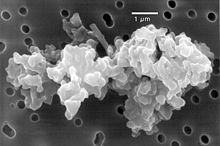Our website is made possible by displaying online advertisements to our visitors.
Please consider supporting us by disabling your ad blocker.
Cosmic dust

Cosmic dust (also known as star dust and space dust) is a type of dust. It is very small crystals sent out from stars.[1][2]
It is formed when a star, such as the Sun, sends out atoms.[1][2] Some of the atoms become ions by gaining or losing electrons and becoming negatively and positively charged.[1][2] These oppositely charged ions form an ionic bond, sticking together in tiny crystals,[1][2] a few thousand nanometres across,[1] to form cosmic dust.[1][2]
Cosmic dust is found in various locations.[3] Intergalactic dust is found between galaxies.[1][3] Interstellar dust is found between stars.[1][3] Dust clouds in these places are found by their blocking light from stars behind them, and by their own infrared radiation. Circumplanetary dust is found around planets and in planetary rings.[1][3] Interplanetary dust can be found between planets,[3] and is seen as gegenschein and zodiacal light.
The coming together of large amounts of dust over time leads to the creation of planets, the Earth, for example.[1][2][4]
- ↑ 1.00 1.01 1.02 1.03 1.04 1.05 1.06 1.07 1.08 1.09 "What is cosmic dust?", How it Works, no. 22, Imagine Publishing, p. 58, 2011-06-16
- ↑ 2.0 2.1 2.2 2.3 2.4 2.5 "Cosmic Dust". Penny Press. 2010. Retrieved 2011-08-18.
- ↑ 3.0 3.1 3.2 3.3 3.4 "What is Cosmic Dust?". wiseGEEK. Retrieved 2011-08-18.
- ↑ "Cosmic dust". Herschel Space Observatory. Archived from the original on 2014-03-05. Retrieved 2011-08-18.
Previous Page Next Page


